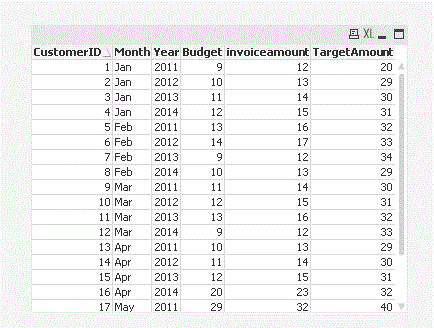Unlock a world of possibilities! Login now and discover the exclusive benefits awaiting you.
- Qlik Community
- :
- All Forums
- :
- QlikView App Dev
- :
- synthesis key
- Subscribe to RSS Feed
- Mark Topic as New
- Mark Topic as Read
- Float this Topic for Current User
- Bookmark
- Subscribe
- Mute
- Printer Friendly Page
- Mark as New
- Bookmark
- Subscribe
- Mute
- Subscribe to RSS Feed
- Permalink
- Report Inappropriate Content
synthesis key
hi
i am having three tables like
SQL SELECT CustomerID,
Month,
Year,
invoiceamount
FROM Invoices;
SQL SELECT Amount,
CustomerID,
Month,
Year
FROM Budget;
SQL SELECT CustomerID,
Month,
Year
TargetAmount
FROM Target;
it creating synthesis key in data model. i am trying to display invoice and budget in chart. month and year as drilldown. if i rename it i am not getting exact result. i tried to concatenate but its not giving exact result.
any help?
- Tags:
- new_to_qlikview
- Mark as New
- Bookmark
- Subscribe
- Mute
- Subscribe to RSS Feed
- Permalink
- Report Inappropriate Content
You can create a common calendar for Invoice, Budget and Target Month and Year and create a Flag in each table to use in set analysis.
For further information search
http://community.qlik.com/blogs/qlikviewdesignblog/2014/02/17/canonical-date
If you still having problems, kindly supply some dummy/sample data to work.
- Mark as New
- Bookmark
- Subscribe
- Mute
- Subscribe to RSS Feed
- Permalink
- Report Inappropriate Content
Every table having three fields in common. so its creating synthesis key i want concatenate month and year fields for three tables any idea?
- Mark as New
- Bookmark
- Subscribe
- Mute
- Subscribe to RSS Feed
- Permalink
- Report Inappropriate Content
You have to concatenate this tables and then you get single table and rename the field Amount as same name in both three tables see the example load script below.
EX:-
SQL SELECT CustomerID,
Month,
Year,
invoiceamount as Amount,
'Invoices' as TableFlag
FROM Invoices;
Concatenate
SQL SELECT Amount,
CustomerID,
Month,
Year,
'Budget' as TableFlag
FROM Budget;
Concatenate
SQL SELECT CustomerID,
Month,
Year,
TargetAmount as Amount,
'Target' as TableFlag
FROM Target;
- Mark as New
- Bookmark
- Subscribe
- Mute
- Subscribe to RSS Feed
- Permalink
- Report Inappropriate Content
so it will create a single table?
- Mark as New
- Bookmark
- Subscribe
- Mute
- Subscribe to RSS Feed
- Permalink
- Report Inappropriate Content
 HI Arul
HI Arul
Join the tables instead of concatenating like below using uniquekey between the tables and renaming the common fields in the other two tables so that they wont create synthetic keys.
LOAD CustomerID,
Month,
Year,
CustomerID &'-'&Month&'-'&Year AS UniqueKey,
invoiceamount
FROM
(
join LOAD CustomerID AS BCustomerID,
Month AS BMonth,
Year AS BYear,
CustomerID &'-'&Month&'-'&Year AS UniqueKey,
invoiceamount as Budget
FROM
(
JOIN LOAD CustomerID as TCustomerID,
Month AS TMonth,
Year AS TYear,
CustomerID &'-'&Month&'-'&Year AS UniqueKey,
invoiceamount as TargetAmount
FROM
(
Regards
Padma
- Mark as New
- Bookmark
- Subscribe
- Mute
- Subscribe to RSS Feed
- Permalink
- Report Inappropriate Content
Yes you are right it is the best way and there is another ways of doing the same situation. Concatenate the Budget and Target tables and join with the Invoices table See the example load script
Ex:-
Budget:
SQL SELECT
Amount,
Year&'_'&Month&'_'&CustomerID as %Key,
'Budget' as TableFlag
FROM Budget;
Concatenate
Target:
SQL SELECT
Year&'_'&Month&'_'&CustomerID as %Key,
TargetAmount as Amount,
'Target' as TableFlag
FROM Target;
Join
Invoice:
SQL SELECT
Year&'_'&Month&'_'&CustomerID as %Key,
CustomerID,
Month,
Year,
invoiceamount,
'Invoices' as TableFlag
FROM Invoices;
Note:- Here i assume the data in the tables Budget and the Target are unique in Year, Month and CustomerID
then load table like this way